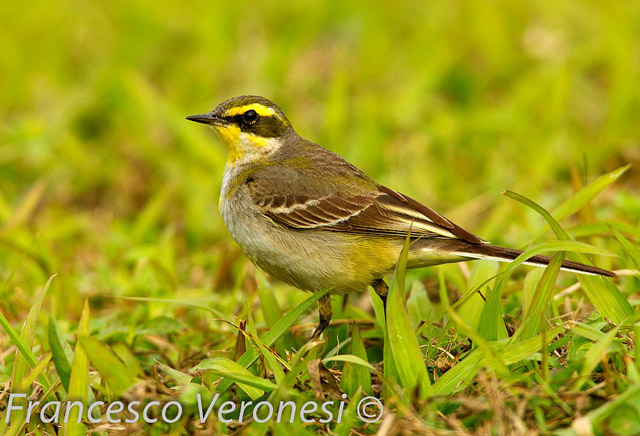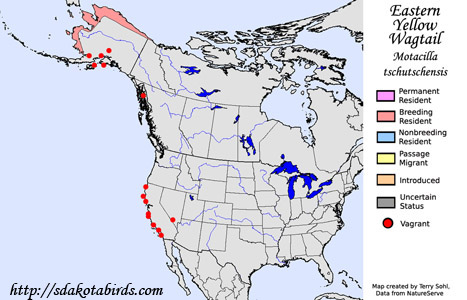| Length: 6.5 inches | Wingspan: 9.5 inches | Seasonality: Non-resident in South Dakota |
| ID Keys: Yellow underparts, olive-gray upperparts, white eye stripe, black cheeks on breeding male | ||
 The
Eastern Yellow Wagtail and the Western Yellow Wagtail (not found in North
America) were recently split from the former "Yellow Wagtail"
(Motacilla flava), although some authorities continue to maintain the old
classification of one Yellow Wagtail species. Most Eastern Yellow Wagtails
are found as breeding birds in northern Asia, but there are also breeding
birds in northern and western Alaska. Long-distance migrants, Eastern
Yellow Wagtails migrate to southeast Asia or the Australia region for the
winter. As with other wagtail species, Eastern Yellow Wagtails do indeed
frequently wag their tail as they walk along the ground, foraging for
insects and other food items.
The
Eastern Yellow Wagtail and the Western Yellow Wagtail (not found in North
America) were recently split from the former "Yellow Wagtail"
(Motacilla flava), although some authorities continue to maintain the old
classification of one Yellow Wagtail species. Most Eastern Yellow Wagtails
are found as breeding birds in northern Asia, but there are also breeding
birds in northern and western Alaska. Long-distance migrants, Eastern
Yellow Wagtails migrate to southeast Asia or the Australia region for the
winter. As with other wagtail species, Eastern Yellow Wagtails do indeed
frequently wag their tail as they walk along the ground, foraging for
insects and other food items.
Habitat: In the Alaska summer breeding range, they are found on tundra, in areas with thickets of dwarf willow or dwarf birch.
Diet: Feeds mostly on insects and spiders, as well as small mollusks such as snails, and other invertebrates such as worms. Also may feed on berries and seeds.
Behavior: Feeds by walking on the ground, often making fast runs to capture insects when they are spotted. They will also sometimes catch flying insects in flight, or hover briefly while gleaning insects from vegetation.
Nesting: The nest of an Eastern Yellow Wagtail is a cup of grasses, weeds, mosses, and lichens, lined with feathers or animal hair. The nest is built on the ground, usually under a small shrub or next to a clump of grass. The female usually lays 4 or 5 eggs, and both parents help to incubate them. When the eggs hatch, both parents help to raise the young. The young leave the nest after about 2 weeks.
Song: Song of the Eastern Yellow Wagtail is a series of repeated short notes
Migration: Long-distance migrant, with birds found in Alaska normally wintering in Australia and southeast Asia.
Interactive eBird Map: Click here to access an interactive eBird map of Eastern Yellow Wagtail sightings
Similar Species: Coloration distinguishes it from other Wagtail species that have been found in North America.
Conservation Status: Populations may be decreasing, but they are still found over a wide geographic area and are relatively common in some areas. The IUCN lists the Yellow Wagtail as a species of "Least Concern".
Further Information: 1) Audubon Guide - Eastern Yellow Wagtail
2) Birdguides - Yellow Wagtail
3) USGS Patuxent Bird Identification InfoCenter - Eastern Yellow Wagtail
Photo Information: Photo taken by Francesco Veronesi - January 7th, 2011 in Taiwan - Photo licensed under Creative Commons Attribution NonCommercial ShareAlike 2.0 Generic License
| Click below for a higher-resolution map |
 |
| South Dakota Status: Non-resident in South Dakota |
Additional Eastern Yellow Wagtail Photos (coming soon!!)
